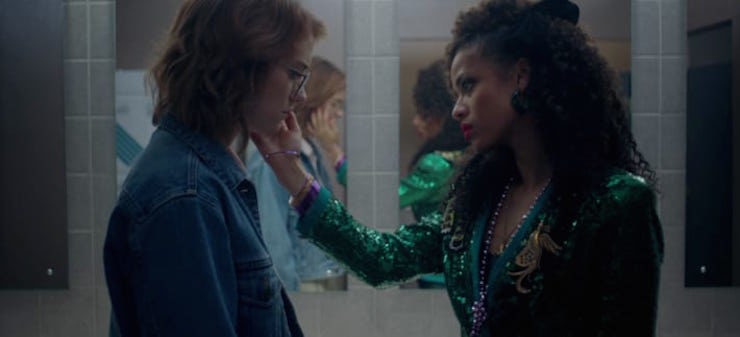Whoa. Could… could an episode of Black Mirror actually have an upbeat ending? Can technology be used for good and not as a way to highlight flaws of human nature? I have so many feels after “San Junipero,” and not enough time to say everything I want to about what’s now become one of my favorite episodes.
Spoilers for Black Mirror 3×04 “San Junipero.”
But first… that playlist. Fire up this Spotify soundtrack made by Redditor seanbperiod as this episode flashes before our eyes.
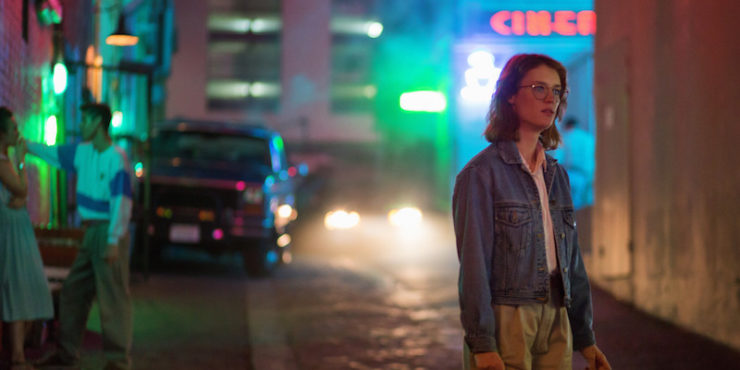
Love doesn’t make it very far in the world of Black Mirror: Marriages crumble under national shame; technology can only conjure a simulacrum of someone lost; being inside each other’s heads leads to explosions from the inside rather than peace. As we know, this is a series about how humans screw up technology, so the fact that it sabotages our love lives shouldn’t be surprising. But what if you have a romance that comes about because of this futuristic tech? A love that can’t be destroyed by it because without it it wouldn’t exist anyway?
“San Junipero,” written by Charlie Brooker, is one of the series’ most layered offerings—due in no small part to director Owen Harris, who previously helmed “Be Right Back.” Harris shares as much credit as Brooker for the truly atmospheric episode, which from its first long shot takes us into the heart of the titular town: a perpetual party in the 1980s, where neon-clad partiers shimmy on the dance floor and giggle over video games, delighting in their youth and their vitality. These beautiful young creatures have no worries, save for their constant glances at the clock and talks of running out of time by midnight. Then, a week later, they do it all over again.
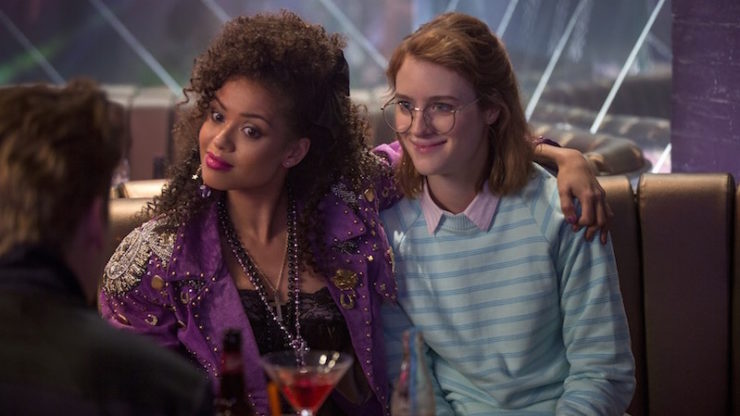
On one of these otherworldly Saturday nights, the adorably repressed, nerdy Yorkie (Mackenzie Davis) wanders into San Junipero’s hoppin’ club, where she meets exuberant lover of life Kelly (Gugu Mbatha-Raw). Though both women enigmatically refer to themselves as “tourists,” they couldn’t have more opposite responses to San Junipero: Kelly is living it up, finding a new dance partner (in all respects) every week, while Yorkie can barely get through a conversation with another arcade enthusiast or the bartender, and looks up at the neon signs and the rain with something akin to wonder. And yet, their chemistry is undeniable, despite Yorkie’s attempts to flee—first embarrassed at being seen dancing with Kelly out in the open, then her excuses that she has a fiancé.
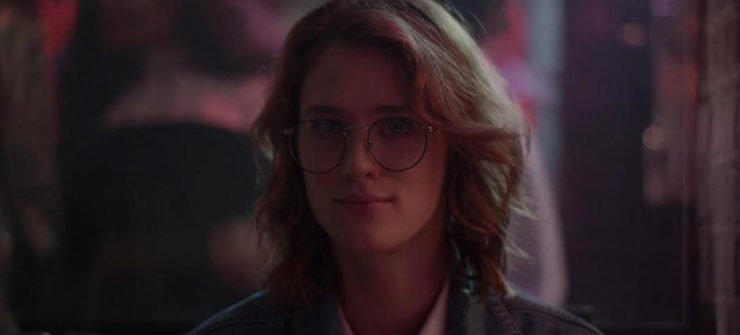
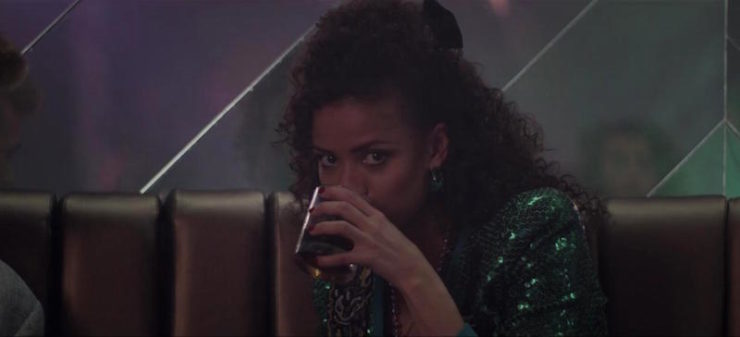
But the next week, Yorkie finds herself drawn to the same club, at the same time, where she tracks down Kelly and fumbles her way through the sweetest proposition (“Can you just make this easy for me?”) before Kelly puts her out of her misery (“Wanna go to bed with me?”). Post-coital, at Kelly’s bungalow on the beach, Yorkie jokes that she “deflowered” her, because she’s never been with a man or a woman. The first real signifier that there’s something weird about San Junipero comes during their pillow talk; aside from Yorkie being a virgin who’s about to get married, Kelly was married, to a man, for a long time. Despite knowing she was attracted to women, she never had the opportunity to explore such a part of her life. But what is clearly a momentous experience for Yorkie seems to be just another Saturday night for Kelly, as she isn’t waiting for Yorkie the next week.
Desperate to find her, Yorkie goes to the ominous Quagmire, which Kelly had described as “If you don’t already know what the Quagmire is, you don’t want to know.” It’s like every scare-tactic description of a depraved sex club turned up to 11, with kinksters and the curious engaging in all manner of public play, some for fun, some rather joylessly. There, Yorkie runs into Wes, another of Kelly’s castoffs, who takes pity on this interloper and suggests that she check the ’90s, or the 2000s, even. As the buildings, fashions, and even “one week later” fonts change, we dash through time with Yorkie, until she tracks down Kelly in 2002, where she’s playing Dance Dance Revolution in impressive gold stilettos. Though initially she brushes off Yorkie, Kelly races after her when she sees Yorkie sitting near the edge of a building.
Now, as you might’ve guessed by now, San Junipero is not the kind of place one should worry about falling to one’s death, but Kelly and Yorkie are tourists, so of course that impulse is still hardwired. Kelly admits that she only wanted to have fun, because she’s dying: She was told she had only three months to live six months ago, so now she’s just waiting for the other stiletto to drop. She wasn’t supposed to fall for anyone, to develop feelings, but here they are.
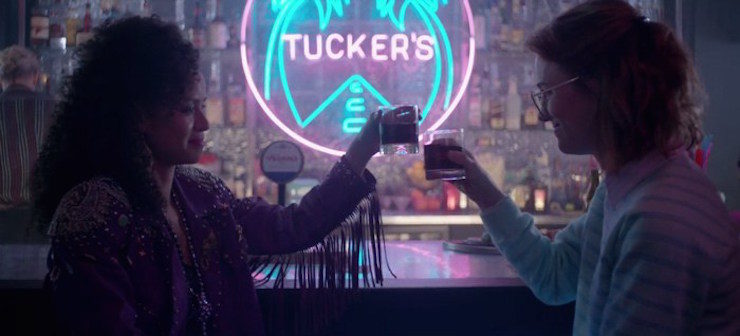
But that’s the thing—they’re not here, not physically. San Junipero is a virtual reality afterlife, a paradise where you can party through every era without fear of sickness or death. The living get only five hours a week—hence their Cinderella-esque deadline—as a free trial before they decide to sign their consciousnesses over after death. And here’s where Kelly and Yorkie’s experiences with the real San Junipero are flipped: Yorkie, who is revealed to be an elderly quadriplegic woman, in a coma after a car crash 40 years ago after coming out to her parents, wants to live in San Junipero full-time. An elderly Kelly visits her in the hospital, in a scene that’s more stirring than any rom-com running-to-the-airport-big-music-swell cliché.
Yorkie’s “fiancé” is Greg, the nurse who has presided over her bedside for years, who agrees to the marriage so he can sign the form authorizing her euthanasia. Wanting Yorkie to marry someone she loves, Kelly offers to do it instead, and signs the forms that send Yorkie to paradise. Unlike the tourists, with their limited senses, she can actually smell the salt air and feel the sand between her toes. She’s ecstatic.

But while Yorkie is all in on San Junipero, she has trouble convincing Kelly, whose husband of 49 years decided not to pass over to San Junipero when he died. “He left you,” Yorkie claims, but that gets her an enraged slap. Teary and furious, Kelly tells her that she doesn’t know anything about the situation: Kelly’s daughter died at 39, before San Junipero existed, and her husband elected not to pass over so that he could be with her in the afterlife. Except that Kelly doesn’t believe in heaven, in anything, after death; she just doesn’t feel right staying on without them. And here’s where Kelly gets defensive and lashes out again: “I pitied you” is her reasoning for marrying Yorkie (just like Greg’s), and Yorkie never asked about her family, never assumed she could have had an entire life before San Junipero. In her wedding dress, Kelly takes off in her truck and purposefully crashes it into a divider… only to go through the windshield and come out without a scratch, because this is San Junipero. Yorkie reaches to help her up, but Kelly disappears; it’s midnight, and the tourist must go home, while the local stays.

Time passes, or whatever passes for time in San Junipero, and we see Yorkie settle in to her new life: She has a snazzy sportscar, she doesn’t need her glasses anymore, she seems at peace for the first time, even more so than after sex with Kelly. Even if she’s alone, she’s living for the first time.
And then—her wife, her confidante, her kindred spirit appears. We don’t see what convinces Kelly to pass over to San Junipero, but after her death that’s exactly what she does. And, set to the sweet strains of Belinda Carlisle’s “Heaven is a Place on Earth,” we get the very best Black Mirror visual pun:
Seriously—better than the groaner in “Playtest.” And you can bet I was happy-sobbing throughout this entire ending sequence and am still getting a little choked up rewatching it today. It’s like the reverse of Six Feet Under‘s final six minutes: Instead of looking ahead to the characters’ deaths, we look ahead to their lives—both in San Junipero and at TCKR Systems, where their little dancing souls sit side by side in a server along with thousands of others. TEARS.
In “Be Right Back,” a woman resurrects her dead significant other by embedding an artificial intelligence—compiled from his obsessive social media postings in life—into a clone body. Of the above examples of love and technology not quite mixing, it’s the closest to “San Junipero” in actually succeeding: Martha (Hayley Atwell) learns to cope with the ghost (basically) of Ash (Domnhall Gleeson), for the sake of her daughter getting to know the father who died before she was even born. In both cases, these emotional decisions are motivated by selfishness warring with selflessness: Martha pushes past her revulsion and her desire to toss the clone over the cliffs so that he might be a presence in their daughter’s life; Yorkie begs Kelly to give their fledgling love a chance, despite the fact that Kelly is tired of life, of love, of loss. A big realization for me, after the truth about San Junipero was revealed, was that this city is pure nostalgia for Kelly and for most others—but it’s all new to Yorkie. If we’re assuming that this is near-future and that Yorkie was in her car crash somewhere around the ’70s or onward, she never lived through these iconic eras. No wonder she has no idea how to navigate, no idea that society is much more welcoming of two women falling in love.
My second realization, even better than the first, was that it took me until two days after watching the episode to notice that the only male characters were small supporting roles (Wes and Greg). The protagonists were two women—one bisexual woman of color, one white lesbian—wonderfully diverse. My only quibble with the plot is that Kelly’s reversal wasn’t explored more, especially considering she made such a good argument for feeling that living full-time in San Junipero would be a betrayal to her family. Yes, we get to witness her decision, as she tells her caretaker:
“Well, OK then. All things considered, I guess I’m ready.”
“For what?”
“For the rest of it.”
Yet I still felt as if a step were missing. Why devote so much screentime to her big speech about being ready for death, only for her to decide that she was ready for the opposite? That said, some insightful commentary from Redditor lilajanet provided an illuminating perspective: The ending of “San Junipero” subverts the all-too-common “bury your gays” trope. It would have been easy to separate Kelly and Yorkie after their brief affair, for Kelly to die and leave Yorkie alone for all eternity, a tragic gay character like Albus Dumbledore and (maybe) Luke Skywalker. Instead, we got to see Kelly take a second chance at love and Yorkie get more than a taste of the life she could have had before her car crash. And that’s worth celebrating.
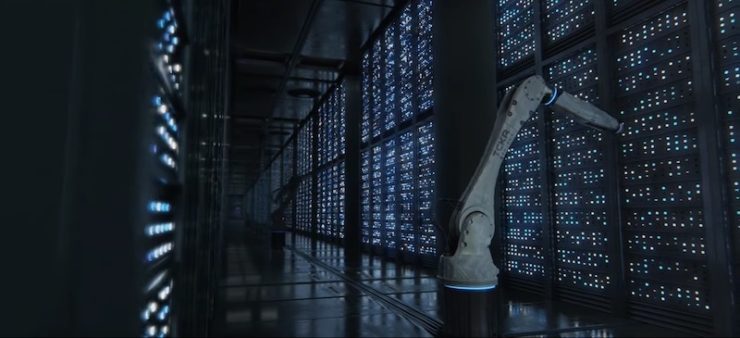
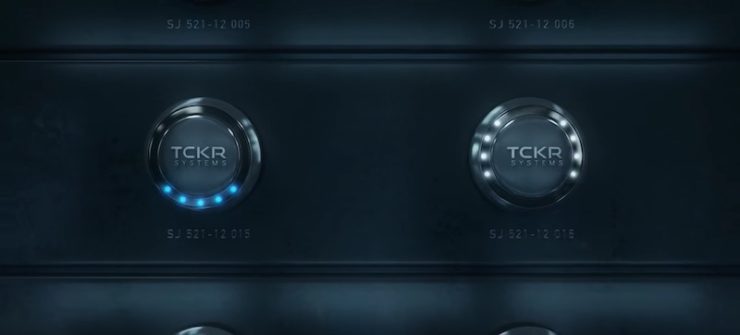
Like “Playtest,” this episode felt out of place tonally within the Black Mirror mythos; and if we hadn’t gotten six episodes dropped at once, I doubt that neither would exist in their current forms. Brooker has said in interviews that they intentionally went for a variety of tone so that season 3 wasn’t unrelentingly bleak; “San Junipero” was as comforting as the mug of hot cider and heavy blanket in my binge-watching experience, because it provided that contrast to the more soul-destroying episodes. Part of me would have preferred it be the last episode of the six, to end this part of the season on an uplifting note, but I don’t know if I would have made it from “Shut Up and Dance” to “Men Against Fire” without a breather.
Other Reflections
- Consider the tagline for The Lost Boys, spotted in the opening shots of 1987: Sleep all day. Party all night. Never grow old. Never die. (Leaving out the “It’s fun to be a vampire” punchline, it’s a cool bit of foreshadowing.)
- Even more rad, a Redditor (named KellyYorkie, aww) pointed out that the hapless guy trying to play video games with Yorkie says something to the effect of “This game has two endings, depending on if you’re playing one player or two.”
- Yorkie’s montage of trying on different album cover outfits was amazing, especially “Addicted to Love” (even if it didn’t suit her personality).
- The ongoing debate I’ve seen on r/blackmirror is the distinction—as in “Be Right Back” and “White Christmas”—that the real Yorkie and Kelly aren’t in San Junipero, just really good, almost-identical copies. Do you think they’re really the two women’s consciousnesses (or even souls, if you want to go that route), or did the copies take over once the bodies died?
Read all of our Black Mirror coverage: “Nosedive” | “Playtest” | “Shut Up and Dance” | “Men Against Fire” | “Hated in the Nation“










